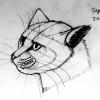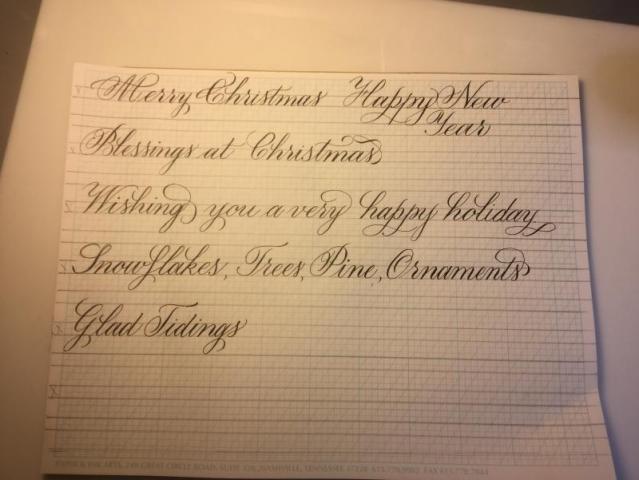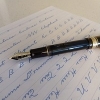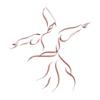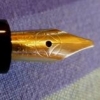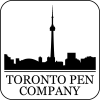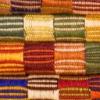Search the Community
Showing results for tags 'copperplate'.
-

Can one smooth the tip of a dip pen nib that is very scratchy?
The Scribe posted a topic in Of Nibs & Tines
I recently purchased a selection of dip pen nibs for Copperplate and Engrosser's Script. Some nibs perform beautifully smoothly on the upstroke like the Zebra G and the Brause EF66. However then there are the Hunt nibs I purchased like the Hunt 101 and 22B which are very scratchy! The Gillot 303 and 404 suffer the same fate. While I can ameliorate the scratchiness by using really smooth paper like Rhodia as well as using a very light touch I am wondering if I can use the same techniques and materials (e.g. 3M micromesh) to lightly round and polish the tine tips of these nibs as I have successfully used on my fountain pens? Anyone had experience doing this?- 6 replies
-
- nibs
- copperplate
-
(and 2 more)
Tagged with:
-

Can one smooth the point of a dip pen nib?
The Scribe posted a topic in Fountain & Dip Pens - First Stop
I recently purchased a selection of dip pen nibs for Copperplate and Engrosser's Script. Some nibs perform beautifully smoothly on the upstroke like the Zebra G and the Brause EF66. However then there are the Hunt nibs I purchased like the Hunt 101 and 22B which are very scratchy! The Gillot 303 and 404 suffer the same fate. While I can ameliorate the scratchiness by using really smooth paper like Rhodia as well as using a very light touch I am wondering if I can use the same techniques and materials (e.g. 3M micromesh) to lightly round and polish the tine tips of these nibs as I have successfully used on my fountain pens? Anyone had experience doing this?- 17 replies
-
- copperplate
- calligraphy nib
-
(and 2 more)
Tagged with:
-
I have recently purchased a new box of nibs, Zebra comic G, for copperplate calligraphy. They're nibs I used in the past with happy results, very flexible and nice fine lines in my opinion. I used them with regular fountain pen inks (like Waterman, Pelikan, Lamy, MontBlanc and so on) but also with some self-made mixes and gum arabic. The old set worked just fine as soon as it was out of the box, no need for cleaning or set-up: they just held ink perfectly. This new box seems exactly the same, same finishing, and it was purchased by the same vendor. However the nibs don't hold ink properly: it will pool around the reservoir and refuse to flow towards the tip. When it does flow, it very often comes down all at once creating splotches. I tried different ones, so it's not just a faulty one of the box. I have tried cleaning them with: saliva - which had worked fine in the past with other nibs: slightly better, but the issue is definitely not solved water - no improvement, almost made the issue worse if possible flame - held it over a lighter, at first just a second, then when it was not working I held it for several seconds: again the situation got somewhat better, but it's not solved Things I heard but haven't tried yet: toothpaste - I'm afraid to ruin the tip: should I go for it? chemicals, like solvents: acetone, nitro thinner or simple kitchen degreaser - I really don't know what's going to happen with the metal and/or the ink. I'm not keen on playing the little chemist, so I'd rather leave this as a last resort. intervening on the ink - maybe some inks will solve this problem? Maybe they need to be thinner? Do you have any recommendation or low-risk methods I could try at first? I really want to solve this because I love these nibs and would be very sad to start looking for different kinds to fall in love with also I have a deadline coming up for a job and need to sort this out rather quickly! Thanks and apologies for my English.
-
In order to improve my handwriting, I'm going through two exercise books: Michael Sull's "American Cursive Handwriting" and Austin Palmer's "The Palmer Method of Business Writing." The former includes practice sheets but the latter doesn't. In lesson 32, page 70, Mr. Palmer writes "As there are six-sixteenths of an inch between the rule lines in the practice paper generally used, and in all the the Palmer Method practice paper... ." So, where do I get this 3/8" paper or "Palmer Method practice paper?" Also, what is Seyes paper? Where do I get French-ruled Clairefonte paper or notebooks? I wrote to Michael Sull and asked him what is the spacing on his Clairefontaine Tablets but didn't receive any response. I also wrote to John Neal Books asking about the spacing of guidelines in their P76 Strathmore Writing Pad, lined, P35 Clairefontaine Lined Pad; and P86 Logos Calligraphy Copperplate Pad, but again didn't receive any response. I don't have access to a printer so I would like to buy paper with guidelines (and maybe 52 degree or 55 degree lines) on it.
- 2 replies
-
- sull
- copperplate
-
(and 1 more)
Tagged with:
-
I'm continuing to work on my Copperplate script, and used holiday greetings and vocabulary here. Feedback and suggestions for improvement are appreciated. I had to switch to a Blue Pumpkin nib midway here because my Brause EF was catching on my paper. Happy holidays to all!
- 3 replies
-
- copperplate
- flourishing
-
(and 2 more)
Tagged with:
-
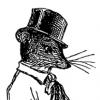
Proof That Instruction And Guides Are Better Than Figuring It Out On Your Own
AAAndrew posted a topic in Pointed Pen Calligraphy
So, about a month ago I began playing around with my first flexible fountain pen, and then for the past few days with some dip nibs and my attempts at shaded writing looked like this just two days ago (the 6th). Yesterday evening I printed out my first practice sheets and started working my way through Dr. Vitolo's wonderful eBook for the iPad Script in the Copperplate Style. It's a multimedia compendium of his articles and videos on how to write using the Copperplate or Embossed style of calligraphy. And then today I was able to run over to John Neal (just an hour west of here) and pick up an oblique holder (was using a straight holder with my vintage nibs). I have a day job so I've only made it through the small letters and a few capitol letters, and only the barest introduction to these forms (no long hours of practice yet), but just that little bit of actually doing it the right way, with the right tools has made my letters only horrible rather than criminal. I still need tons of work on just about every aspect (sizing, consistency, proportion, angle) but already I can see a huge difference. So, if you're wanting to learn, don't try to do it on your own. Find some good instruction, there is a lot out there for free on the internet, and the practice sheets you can get for free on the IAMPETH web site truly make a difference. And if you own an iPad, download this free book now. It's incredible with great explanations, illustrations and even embedded videos. It will make a huge impact on your progress.- 15 replies
-
- pointed pen
- beginner
-
(and 2 more)
Tagged with:
-
Hello, I have been considering some different flex pens for copperplate and as I can already write with a fountain pen and messed about with some of my friends flex pens, which pen would be better. I am looking mainly at either a modified fountain pen with a zebra g nib, a cheep calligraphy set or a vintage Conway Stewart 759. Any help would be appreciated.
- 13 replies
-
- flex pen
- copperplate
-
(and 2 more)
Tagged with:
-
I'm thinking about buying a Desiderata Pen for Copperplate calligraphy. Most of the time, I use a proper pointed dip pen and calligraphy ink for Copperplate, but sometimes I'm lazy and use a Noodler's Ahab for practicing so I don't have to clean my nibs. Plus it's a good way to use all this fountain pen ink I have! I'd like to find a flex nib pen that gets a closer feel to a true pointed pen. If you have experience with a Desiderata Pen, can you do Copperplate with it? How is the experience of using the pen? Will the feed be able to keep up with the flexible nib ink flow? Thanks so much to anyone who can help!
- 8 replies
-
- calligraphy
- copperplate
-
(and 1 more)
Tagged with:
-
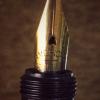 First of all greetings to all I am new at The fountain pen network and in the magnificent world of fountain pens at the moment I only have one lamy logo and within a month I will get a 2000 lamy. I am a young man of 20 years old who since childhood my mother taught me the art of writing. I use the palmer method to write and I love it and more when I use stub nibs because of the effect of line variation.And I've had some curiosity about trying out new calligraphy styles like Spencerian or Copperplate and I really do not know which one to start with first and which one is going to make it easier with Palmer's bases.and with respect to the tools that are used I have never used flexible nibs I have only used round and stub, I do not really know how hard a flex is.So what do you recommend? Is it worth trying or should I continue with palmer?I also leave some samples of my handwritingDocumentos escaneados.pdf
First of all greetings to all I am new at The fountain pen network and in the magnificent world of fountain pens at the moment I only have one lamy logo and within a month I will get a 2000 lamy. I am a young man of 20 years old who since childhood my mother taught me the art of writing. I use the palmer method to write and I love it and more when I use stub nibs because of the effect of line variation.And I've had some curiosity about trying out new calligraphy styles like Spencerian or Copperplate and I really do not know which one to start with first and which one is going to make it easier with Palmer's bases.and with respect to the tools that are used I have never used flexible nibs I have only used round and stub, I do not really know how hard a flex is.So what do you recommend? Is it worth trying or should I continue with palmer?I also leave some samples of my handwritingDocumentos escaneados.pdf- 51 replies
-
- calligraphy
- fountain pen
-
(and 3 more)
Tagged with:
-
Learning Copperplate As promised, I am adding my Copperplate lessons here. We will start our study of Copperplate with the small letters i.e. the minuscules. I have divided the minuscules into four groups. The first three groups are based on strokes common to the group. The last group contains the letters that do not share a pattern with other letters - these are the misfits. The process is that students will study each lesson, do their practice and submit the assigned words for feedback. Students move on to the next group only when sufficiently proficient with the current one. Each group will have it's own thread so things don't get mixed up. We will need some materials before we start. I always recommend using the best materials you can afford for practice. The time we spend practicing is our most valuable asset. It does not make sense to waste a second of it fighting with uncooperative paper or ink that doesn’t flow well. Here is what I recommend: Ink: I will start with ink because it determines the other materials to some degree. I know the following to work well: Higgins Eternal with a few drops of Gum Arabic. Walnut ink (can be bought in liquid form or as crystals that are dissolved in water to make ink). Pelikan Black with a good dollop of Gum Arabic - experiment to find what works best for you. Noodler’s Black with a good amount of water added. Fountain pen inks contain surfactants which sometimes causes the ink to slide off the nib in an uncontrollable manner. The last two inks on my list are fountain pen inks but work well with pointed pens in my experience. Please feel free to experiment with other inks but stay away from pigmented inks like Sumi or India. These can be made to work well with pointed pens but I don’t think it is worth the effort to fiddle with these inks when one is learning. Paper: The paper you use should be smooth and should be able to take the ink you have chosen to work with. Higgins Eternal has a higher tendency to bleed than the other inks but it flows well. Some experimentation will be needed here. Also, I recommend printing the guidelines on the paper you will be writing on. It makes a big difference over placing printed guidelines underneath the paper you are writing on. The paper you choose should be suitable for printing guidelines on the type of printer you have. You can use paper with pre-printed lines on it e.g. Rhodia pads. Please make sure the lines are at least 6mm apart though. On such papers you will only need the slant lines. We will be writing Copperplate at the traditional 55 degree angle from the baseline. You can either draw these on your paper or place a printed sheet with just the slant lines underneath. Nib(s): We will be writing the minuscules at ¼ inch x-height i.e. letters without ascenders or descenders will be ¼ inch tall. We will need a nib that can handle writing at that size. I can recommend the following: Speedball Hunt 101. These are commonly available in art stores and work very well. Speedball Hunt 22. These are stiffer than the 101’s and a bit smoother. These work well for people who find the 101 difficult to use. Brause 66EF. These are easily available online and in some stores. This is very small nib but has more than enough flexibility for our purposes. It works well with inks that might be problematic with other nibs. Because of it’s small size, it needs a specially adjusted holder. Leonardt Principal EF. This is an excellent nib and could have been at the top of the list. I have placed it at no.3 because it requires a delicate hand to get the best performance from it. Also, there have been reports of loss of quality lately (new nibs turning out bad). Gillot 303. This is also an excellent nib but can be hard to use as it requires a delicate touch on the up strokes. There have been quality issues with this nib too but reportedly Gillott has invested in new tooling that will take care of these issues. Nibs produced with the new tooling are expected to be available in a few months from the time of this writing (May, 2016). Various G nibs are very popular and often recommended for beginners because of their forgiving nature. These are excellent nibs but are a bit too stiff for writing at the size we will be practicing with. By all means get some (my favourite is the Zebra G) to play with. You will definitely find a use for it outside of these lessons - or for practicing Copperplate at a smaller size. Holder(s): Oblique holders are usually recommended (but not absolutely necessary) for right handed people. I use one and do recommend it highly. However, you can write Copperplate with a straight holder if you want. You will need to turn the paper so that the slant lines are lined up with the direction of your holder shaft. The goal is to allow the nib to spread evenly on both sides of the shade on the down strokes. Left handed people, if they are underwriters, can use a regular oblique holder (like the one used by right handed people) and write with the paper turned clockwise between 40 and 60 degrees. It is difficult to draw the hairlines as upstrokes using a straight holder. One of the advantages of an oblique holder is that it presents the nib at a shallow angle to the paper. This helps sharp nibs make smooth hairlines on the upstroke without catching on the paper. In my opinion, this is a big enough advantage to consider using one - even for left handed scribes. Left handed oblique holders are available but I believe a regular one works better for left handed calligraphers. Guidelines: As mentioned above, we will be using ¼ inch x-height. I have prepared the guidelines in 2 sizes, A4 and US Letter. Both are attached to this post as pdf files. Please download the appropriate one and print it out on the paper of your choosing. The illustration shows how the guidelines are laid out. The traditional proportions for Copperplate are 3:2:3 i.e. the ascenders and descenders are 1.5 times the x-height. However, at the ¼ inch x-height we are using, the ascenders will be hard to draw at those proportions. We will be drawing our ascenders and descenders at 1 times the x-height. Some exceptions apply though and will be noted as we go along. http://thesixapp.com/smk/CopperplateLessons/Copperplate-Guidelines-Explained.gif Copperplate Minuscules - Group 1 OK - enough about the preparation. Let's get started with some Copperplate. The first group of letters we will be working are based on the ‘i’ stroke i.e. the stroke that makes up the letter ‘i’. The ‘i’ stroke starts at the waist line and goes down to the base line. The stroke is started at full shade (i.e. the full thickness of the letter) and drawn at this thickness down ⅔ rds of the way down. As the illustration shows, pressure is released in the last third while simultaneously moving the pen to the right. This causes the right tine of the nib to keep drawing a straight line down while the left tine closes down making an arc as the tines come together at the base line. This is where you stop. Pick up the pen off the page and put it back down to start the hairline stroke that will connect to the following letter if there is one. http://thesixapp.com/smk/CopperplateLessons/structure-i.gif The picking up of the pen ensures that the bottom of the shade comes to a point as well as avoids pulling excess ink into the hairline. Here is the group of letters based on the ‘i’ stroke: http://thesixapp.com/smk/CopperplateLessons/CuPl8-group1.gif i - Start with a hairline at the base line and go up to the middle of the x-height or slightly above - this is the entry hairline. Now place the pen at the waist line and apply pressure to the nib to spread the tines and pull down towards the base line. The stroke should be placed such that it meets the entry hairline halfway down the stroke. Gradually release the pressure on the nib two-thirds of the way down while moving the pen to the right bringing the stroke to a point on the base line directly below the right side of the stroke. This will cause the left side of the stroke to have a curved shape. Now lift the pen for a beat, put it back down and draw the hairline back up to the middle of the x-height, this is the exit hairline. The dot is placed directly above the ‘i’, halfway between the waistline and the the 1st Ascender line. It is the same thickness at the letter - no more. You can go back and make the top of the starting stroke ‘square’ now. In time, you will learn to square the tops directly at the start of the stroke but there is no need to spend time on it at this time. It is worth your while to practice this stroke until you can do it without thinking. The best way to do that is to use Mr. Geoff Ford’s method of practicing in groups of 5. Here is how you do it: Write the letter 5 times. Now stop and look at each letter you have drawn and place a tick mark against ones that are good. Now pick the best one and try to replicate or improve on it 5 more times. Repeat. This process not only take the boredom out of the practice, it helps sharpen the eye in the process. Once you can see what a good letter is, making it well is just a short distance behind. So when do you know when you have it? When you can consistently make 3-4 out good ones in a group of 5. u - All that practice with the ‘i’ will come in use here. The ‘u’ is nothing more than two ‘i’s written next to each other i.e. the exit hairline of the first ‘i’, is the entry hairline of the second. All done. w - The ‘w’ is just a ‘u’ with the exit stroke drawn all the way up to the waist line. The ‘blob’ in the end comes ⅓ of the way down and back up to the waistline, or the following letter if there is one. You can draw the blob without any pressure on the nib and then fill it in - or you can make it one go if you feel like it. Please note that the hairline stroke becomes pretty much parallel to the main stroke as it reaches the waistline - it does not curve back into the letter. t - Now things are getting interesting. The ‘t’ is drawn like an ‘i’ that starts halfway between the waistline and the 1st Ascender line and goes down to the baseline. The tapering at the bottom is the last third of the ‘i’ part of the letter so if you cover the tops, the bottoms of the ‘t’ and the ‘i’ would look the same. The crossbar is drawn halfway between the top of the letter and the waistline. l - This is beginning to feel like cheating now. The ‘l’ is just and ‘i’ that starts at the 1st Ascender line and goes all the way down to the baseline. As with the ‘t’, the tapering at the bottom should match that of an ‘i’. b - The ‘b’ is an ‘l’ that is finished like a ‘w’ i.e. the exit stroke it taken all the way to the waist line and then the blob is drawn. j - Things were getting a bit repetitive with the ‘i’ stroke so we will play with something a little different. The ‘j’ is not strictly based on the ‘i’ stroke but it begins like one. It is used in a few other letters so practising it with the first group will pay dividends later. You start just like with the ‘i’ but keep moving down at full thickness through the baseline. As you move below the baseline, start to taper your stroke towards the right gradually until you come to a point at about the 1st Descender line. Continue to draw the stroke as you go a little (about 1/3rd) below the 1st Descender line and come around to form the bowl of the letter and go up to join the downstroke just below the baseline where you lift the pen. The exit stroke continues on the right side of the downstroke as a hairline. The reason you pick up your pen is to avoid drawing excess ink into the hairline exit stroke from the still wet downstroke. The dot is placed above the main stroke just as in the ‘i’. This completes our first group. Take your time with it. When satisfied with your work, post the following words for review: ill, will, built, jilt and a word of your choice made up of these letters. A note about joins: This is the standard join when the hairline exiting at the baseline joins the following letter at mid-height between the base and waist lines. This is the simplest join. http://thesixapp.com/smk/CopperplateLessons/joins/till.jpg Care should be taken to make the join as seamless as possible. Leaving a very small gap (as in the first hairline before the ‘t’) helps to avoid ink from the following shaded stroke bleeding into the hairline. This is quite acceptable although the gap in this example is a bit too big. The exit hairline should be nearly in line with the slant lines at mid-height. This ensures that the join with the following letter is seamless. The second type of join in Group-1 is from letters that end at the waist line. http://thesixapp.com/smk/CopperplateLessons/joins/wit.jpg These letters (‘w’ and ‘b’) end with a blob at the top of the final stroke. This blob is drawn about ⅓ of the way down from the waist line and a looping connector is drawn to the following letter. The bottom of the loop is about halfway between the waist and base lines allowing a join to the following stroke a little below the waist line. This join is slightly steeper than the ones starting at the base line but the transition can still be made smooth by drawing the hairline loop in such a ways that it matches the slant of the letters at the place where it joins the following stroke. Video Demonstration I made a short video demonstrating the letters in this group with the exception of the 'j'. I will add that in the future. You can find the video here: Copperplate Lessons - Group 1 I made a separate video for the 'j' stroke as I also wanted to tackle the 'g' and 'q' at the same time. You can view it here: Copperplate Lessons - j, g & q Copperplate-qtr in-US Letter.pdf Copperplate-qtr in-A4.pdf
- 2 replies
-
- copperplate
- tutorial
-
(and 1 more)
Tagged with:
-
Hello FPNers, I'm all about vintage flex and want to use a rough adaptation of Copperplate for journaling and letters. A while back I purchased a lovely little gold-filled ring top Wahl FP with a wet noodle #2 nib. The nib writes about a Western EF when not flexed, so I'd like to get a finer nib. My question is: should I have the nib reground to a finer point for calligraphy purposes or should I get another pen entirely? Will the small size of the pen make it harder to control for styles like Copperplate or Spencerian, or does the weight of the all-metal construction make up for it? Control is fine with the EF nib, but I'm wondering if it will be harder to control with a needlepoint nib. My big pen purchase goal for next year is to score a wet noodle Waterman 52. Would it be better to have the nib on a larger pen like that made into a needlepoint? Thanks for any advice!
- 48 replies
-
I have a suspicion that I have ignored a specific but essential part of the formula for easy use of flex pens -- which ink works? The variation of line width in flex writings depends on the ink flow creating a consistent connection and fillng of the line being developed between the tines. When the flow of ink only flows off the tines, not remaining connected across the gap between them, you get railroading. When the ink stretch between the tines is not broken as the pen moves a clear, solid line develops as the ink transfers to the paper. Often wide stretch between the tine breaks the ink bridge by not feeding the ink to it quickly enough -- or ink running out on the tines not transferring to the nib from the feed quickly enough. So far this newbie (me) has found a plethora of articles and videos on fitting nibs and feeds, modifying feeds and writing slowly -- but so far no real analysis or comparative testing of fountain pen inks for their efficacy of use or appropriateness for flex use. Also noted are the notes that India ink has the proper viscosity for flex use in dip pens, but is rotten for use in fountain pens clogging them, corroding them and doing bad things. Also articles indicate that fountain pen inks vary viscosity and "stretchability" between the tines not only by brand, but often by color within brand. And sometimes, batch to batch, an ink will limit or open the width of line being attempted at a normal speed before it breaks the bridge or runs out of the nib/feed arrangement. So, the question then becomes what inks work or do not work for fountain pen flex work and within what parameters of width, speed of movement, color, feed type and feed modification, and which do not work? Is there a brand that consistently, across colors or partly in XXX colors that will work well in flex? Is there an additive that can be put in to an ink that normally would not flex which would increase the ink's range AND not damage the fountain pen. Dip pen users use gum arabic for this addtive, but none recommend using that substance in fountain pens citing severe gumming and plugging issues. Maybe this is the sort of challenge Nathan at Noodler's could take on to release a line of designated flex friendly inks in various colors or somehow mark current inks as to "flexworthiness." This might not be a profitable set of tests/developments at first, but I imagine it as a fun challenge. Lastly, if you got this far -- what has your experience shown so far as the best ink to use for flexing -- and does that vary drastically with the nib metal, feed configuration. and cleaning regime required for your flex pen?
- 1 reply
-
- flex nib
- copperplate
-
(and 2 more)
Tagged with:
-
Beauty through Adversity - This thought kept echoing in my mind as I was carving this holder. Just like a hardship caused this Maple to become so uniquely beautiful, we too become stronger, better and uniquely beautiful through adversity. This holder celebrates the beauty in all of us as we face life's trials and tribulations. It is available in my online store along with a couple of others :-) - Salman
- 8 replies
-
- calligraphy
- lettering
-
(and 4 more)
Tagged with:
-
Hi there, I am an avid user of fountain pens and I also love to write with an italic or stub nib for calligraphy. However, I'd like to venture into copperplate and Spencerian script so I'm looking for dip pen nibs. I want to be able to write small letters so that I can write things like letters without running out of space. I'm new to this area so I don't know if it's possible or even desired to have writing that would fit onto the lines of standard lined paper, but that is what I'm looking for. Any suggestions for nibs? Also, is it necessary to have an oblique holder for calligraphy? Thanks, Danny
-
I am happy to announce my workshop on Copperplate Calligraphy on January 7th 2017. I will be introducing my system for learning Copperplate Calligraphy in this 4-hour workshop. We will work through the fundamental forms that make up the minuscule (small) and majuscule (capital) letters of the alphabet. This class will benefit both beginners and those with some experience in Copperplate or other pointed pen scripts. Tickets for this even are available here: Copperplate Calligraphy with Salman Khattak - Jan 7th, 2017
- 6 replies
-
- copperplate
- calligraphy
-
(and 3 more)
Tagged with:
-
I am offering a small selection of these premium holders just in time for your Christmas shopping. These are all ready to ship and available in my Etsy store at: Expressions Art Shop 1-1 & 1-2 - These are my 'short-form' holders. These 4.5 inch holders are carved from Cherry with Zebrano and Rosewood accents in the grip area and Bubinga in the finial. Although short, they feel like full sized holders in the hand. ($120 for the set) Sold 2 - This 'Swan' holder is carved from Cherry. It was a challenging project but I am happy how it turned out. ($140) 3 - This 'Tulip' holder is carved from Bloodwood and Tree of Heaven. ($140) Sold 4 - This classically styled holder is carved from Olive wood for the grip area and Bubinga for the shaft. Two Brass ring accents are placed where the two woods join. The finial is separately carved from Curly Maple and Ebony. ($140) 5 - This holder combined light and dark Walnut and sports a triangular grip. It will suit users with a modern grip who like to hold their pen high. ($120) Please feel free to browse my Etsy store or PM for purchase or custom orders. - Salman
- 3 replies
-
- calligraphy
- holder
-
(and 1 more)
Tagged with:
-
Practitioners of Copperplate and Engrosser's Script know that the spacing in these scripts is fairly 'automatic' i.e. things fall in place rather nicely when the exit hairlines are drawn correctly and meet the following letter at about halfway up the x-height. It is interesting to ponder exactly why that is so. It turns out (no pun intended) that the bottom turns of the straight letters (i, t, l) etc are actually similar to the rounded letters (o, c, e). When drawn correctly, i.e. like the bottom right side of an 'o', exit strokes will be at the correct angle (i.e. match the slant) when they meet the following letter. What is even better is that the join won't be jarring even if the hairline meets the following letter a little bit below the halfway point - this typically results in an abrupt 'impalement' of the hairline into the following letter if the hairline is drawn a bit too shallow. Here is an exercise I give my students. The following image shows the bottom halves of 3 words 'ice', 'lit' and 'tie' - can you tell which one is which? (you can see the whole image here) The challenge is to write these three words and see if the bottom halves give them away. I will be looking forward to your participation. - Salman
- 4 replies
-
- copperplate
- engrossers script
-
(and 2 more)
Tagged with:
-
Question Regrading The Forefathers Of Copperplate And Spencerian- And Their Paper
calligriophile2 posted a topic in Calligraphy Discussions
Nowadays, when one wants to begin to learn copperplate,or spencerian, one of the first questions I usually see is "well, what kind of paper should I get?" Granted, there is nothing wrong with wanting the best paper for the job, and in todays market, there seems to be a plethora of paper types that are made spegifcally for pointed pen calligraphy, which I am admittedly extremely thankful for. That being said, I always wonder if the pioneers of pointed pen calligraphy were as spoiled as us when it came to paper selection. In my mind, I cant help but imagine that, in its infancy,calligraphers had very few types and weights of paper to choose from. I know that as calligraphers today, we are fortunate that there is seemingly "special paper" designed to be used in the different disciplines of handwriting/calligraphy. Can anybody offer me some insight as to whether or not a copperplate calligrapher could go out and buy practice pads specifically for use in copperplate or spencerian scripts, or did they have to make due with what they were able to obtain ? Just a question that I have always thought about bur figured if I askedn it here, I'd be thought of as some one who had a very limited knowledge of what penmanship consister of in the early days of the Golden Age of penmanship.- 2 replies
-
- copperplate
- spencerian
-
(and 1 more)
Tagged with:
-
I've been looking through old convict records and felt the need to share some of them:
-
Hello! This is my first post in the calligraphy section, and I have a question ...but first, a brief intro: I've been tackling with flexible handwriting ever since I got my first Noodler's flex pen, and what a bumpy road it has been... My first flexy nib was incredibly stiff, so I reoriented towards vintage flex, but that turned out to be misleading as well (couldn't find a pen to fit my style). Long story short, it's long since I've sold almost all of my flex pens, keeping only a modified Noodler's nib (ease-my-flex mod) for messing around. And the level of 'messing around' I'm at right now...looks like this: http://i.imgur.com/LHM9H64.jpg (W. B. Yeats' 'Aedh Wishes for the Cloths of Heaven' in Apache Sunset with Noodler's Ahab Ease-My-Flex nib) Feeling that I've started making a bit of progress, I decided to get an oblique pen holder and some decent nibs...problem is, the art stores in my country have a very limited range of flexy nibs (like 1 or 2 variants...) and no oblique holders! After a bit of browsing, I found a nice English webstore with everything I needed; ordered a Speedball oblique holder and 4 nibs (to see which would fit me best): Gillott 404, Leonardt EF Principal, Leonardt Shorthand DP40 and Brause Steno 361. I've read good reviews about the first 3, and I just liked the way the 361 looked Now...after all this useless blabbering comes my question: which other nibs should I consider in my endeavors of learning proper Copperplate (and maybe Spencerian later)? Thank you! (I apologize for the horrendous quality of the photo)
- 21 replies
-
- copperplate
- calligraphy
-
(and 1 more)
Tagged with:
-
Hi all, I am excited to announce my upcoming class on Copperplate Calligraphy. This 6-hour class will be held at Wonder Pens in Toronto. This is a Level-1 class where we will start our study with the structure of the minuscule letters. Both beginners and practitioners of Copperplate are welcome. The class is limited to 10 students. This ensures that I will be able to spend plenty of time with each participant. Further details are available at: Copperplate Class with Salman Khattak I hope to see some FPN'ers there. - Salman
- 2 replies
-
- copperplate
- calligraphy
-
(and 2 more)
Tagged with:
-
Hi all For about the past month and a bit I've been practicing writing in Copperplate because I love the look and style of it and always wanted to write in it. But now I'm getting to the point where I'm becoming more confident at it, so I'm wondering where I go from here to get a little more from the art and use it in a creative and (hopefully) fulfilling way? If I just carry on writing sentences and doing drills I'm sure I'm likely to get bored, and end up dropping it to chase another dream. So what do you all do to add a bit of spice?
-
Hey guys! Just sort of polling the community here. I'm curious as to what scripts you all are learning! Do you think it's a good idea to practice two scripts at the same time? I've been learning Copperplate but recently my eye has really been taken by the beauty that is Spencerian. Should I double team them or focus on one? Thanks and can't wait to hear what you all are learning!
- 16 replies
-
- scripts
- copperplate
-
(and 2 more)
Tagged with:
-
Hi! I just joined this network, and I'm new to calligraphy world. I'm looking for a workbook to practice copperplate font. Suggestions?
- 12 replies
-
- copperplate
- practice
-
(and 1 more)
Tagged with:
-
I'm really fond of the dip nibs especially my Brause No 141 . But I'm looking for a flex nib Fountain pen under Rupees 1000 . I have no qualms about the exterior design I rather hardly care about its age . But then I'm low on budget right now and wouldn't mind a bad looking pen I just want an Extra fine or fine tipped flex pen . I have checked the Lucknow stores the price they quoted me was over 25000 .I have high hopes from FPN.
- 8 replies
-
- flex
- copperplate
-
(and 1 more)
Tagged with:

